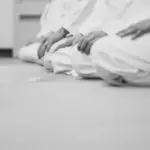When you’re facing a bigger opponent, it’s hard not to get overwhelmed and believe that you have no chance. Being a smaller fighter means that you’ll have to get creative to win, but does that mean that size matters in Brazilian Jiu-Jitsu?
Size does matter in Brazilian Jiu-Jitsu, and if both opponents are equally matched, the larger opponent will typically have the advantage. But, differently sized people will use different strategies to take advantage of their size strengths. For example, smaller people can use speed while larger can use pressure.

So how do you take on someone twice your size in a fight without getting beaten up? Read through the tips in this article to learn how smaller fighters can take their disadvantage and turn it into their strength.
Does Your Height Make A Difference?
Height in Brazilian Jiu-Jitsu can undoubtedly be an advantage if two opponents are standing and they both have an equally matched standing game.
The taller individual can use jabs to keep their opponent at a distance without letting them get too close to land punches of their own.
This is a huge advantage in boxing when opponents don’t have the option to take their counterpart to the ground.
It is different in Brazilain Jiu-Jitsu since your opponent can take you down, but only if they can get close enough to attempt a takedown.
On the ground, it is the shorter person’s advantage since there is more area to work with.
The taller person will eventually expose their limbs, leading to a potential armbar or leg lock.
The shorter individual can also escape from potential submissions easier since they have less surface area being exposed to their opponent.
But one area that the shorter individual needs to worry about is if their own limbs may be too small to effectively hold a submission in place.
Especially chokeholds can be challenging since the opponent’s neck will be larger than what they are used to.
How Weight Can Be An Advantage
Plenty of stories in BJJ are told about smaller opponents beating bigger opponents, and it brings back memories of the David versus Goliath story.
The truth is that weight can be an advantage but only if there is a significant weight disparity or the opponents don’t have a big difference in their skill levels.
When you take a blue belt that weighs 200 lbs and match them against a black belt that only weighs 150 lbs, there is a good chance the blackbelt will win the match.
The skill levels are too far apart for the blue belt to be able to respond effectively regardless if they have an extra 50 lbs on them.
But if you have two opponents who are equally matched and there is a weight disparity, there is a slight advantage to the heavier opponent.
Not only does this person possess more potential power in their punches and kicks because of the extra weight, but they can also use this weight as leverage against their opponent.
They can play the top game on their opponent and cause the lighter individual to have to work harder to fight off the attack rather than if the positions were reversed.
When the fight goes into later rounds, the heavier fighter needs to worry about their stamina more, and their weight can become a disadvantage.
Carrying more weight through a long fight can be more tiring if the fighter hasn’t been used to fighting at these lengths.
Can A Smaller Person Beat A Larger Person?
A smaller person can beat a larger opponent in BJJ, even if they are evenly matched. The smaller person will use the advantages of speed, agility, and dexterity to overcome the larger opponent. Strategy and fight IQ will also have a role in beating the larger opponent too.
It’s possible that a smaller fighter can beat a larger person, but as mentioned above, it depends on several factors.
If the fighters have a difference in their skill set, the smaller person can absolutely beat a larger fighter.
It doesn’t matter how much a fighter weighs or how tall they are; if the smaller fighter has more skills, they can easily take down their opponent.
Above is a video of Marcelo Garcia beating a much larger opponent. Marcelo Garcia is a smaller BJJ competitor winning multiple top finishes at ADCC in his weight class and placing in the top 3 in the open weight class!
Marcelo is only 5’6 (1.73m) tall and competed at 170-180lbs (77-82kg), but would take on opponents much, much larger than he was, and at a comparable skill level. He took advantage of his smaller frame to move quickly to gain the advantages and used his fight IQ to get the upper hand!
Example Outside Of BJJ
A classic example is when the legendary Fedor Emelianenko fought Hong Man Choi.
Fedor was only 6 feet and Hong Man Choi was a towering 7 foot 2 inches.
Throughout the fight, Fedor employed a brilliant strategy and was able to chop down the taller fighter and eventually won the fight.
This isn’t always the case, though, and smaller fighters who are more equally matched with larger fighters can have a tough time if they aren’t able to take their opponents to the ground.
The range at which the taller fighters can keep smaller fighters can sometimes be too much.
It creates a bubble which the smaller fighter has to continually penetrate to even get close to their opponent.
Strategies For Smaller Fighters
It might not always be a literal case, but smaller fighters need to “throw the first punch” at their opponents.
In a larger context, this means that smaller fighters need to set the tone and let the larger fighter know it’s not going to be easy to take them out.
Start aggressive and attack often in the first few minutes of the fight.
They don’t always have to be fully committed punches or kicks, but you need to at least let the opponent know you’re serious.
Smaller fighters also need to keep moving. Part of the advantage of being smaller is that you should be quicker than a larger opponent.
Use that to your advantage and begin to move circles and tire your opponent out by continuing to make them reach for you and throw punches and kicks that don’t work.
This can also leave your opponent open to counters so you can easily dodge their attack and leave them vulnerable.
Another key is not to be afraid to get scrappy.
The taller opponent is doing everything they can to keep you feeling small, so it’s your job to do all the little things to gain an advantage.
Throw kicks when it’s not expected and come at angles they aren’t used to seeing.
This will keep your taller and bigger opponent surprised and on their toes so they won’t know how you’re going to attack, and they will be on the defensive.
Bruno Malfacine is a smaller Brazilian Jiu-Jitsu fighter that constantly had to fight guys bigger than him.
He has built an entire course on how to beat guys that are bigger than you.
Strategies For Larger Fighters
One of the best things you can do as a larger fighter is using your size advantage as leverage over the smaller fighter.
One of the best ways to do this is by taking your opponent to the ground and leaning on them heavily.
This will make the smaller fighter need to spend more energy on trying to get out of the bad position and they could tire easily.
If you feel your standing game is stronger than your opponents and are worried about going to the ground then having a longer reach is going to come in handy.
Begin to use more jabs and straight kicks to keep your opponent at a distance.
This will keep your smaller opponent from getting too close and potentially taking you down.
The goal is to not let your smaller opponent feel like they could be in control of the match or have hope that they could win.
Chances are they won’t be too confident heading into a match with a larger opponent and it will be your job to keep it that way.
Summary
Size can and does matter for most fights, but it doesn’t always have to mean the smaller fighter is at a disadvantage. Knowing how to fight against bigger opponents and using the techniques of smaller fighters can turn that disadvantage into a clear strength. Skill will always beat size if used properly.


